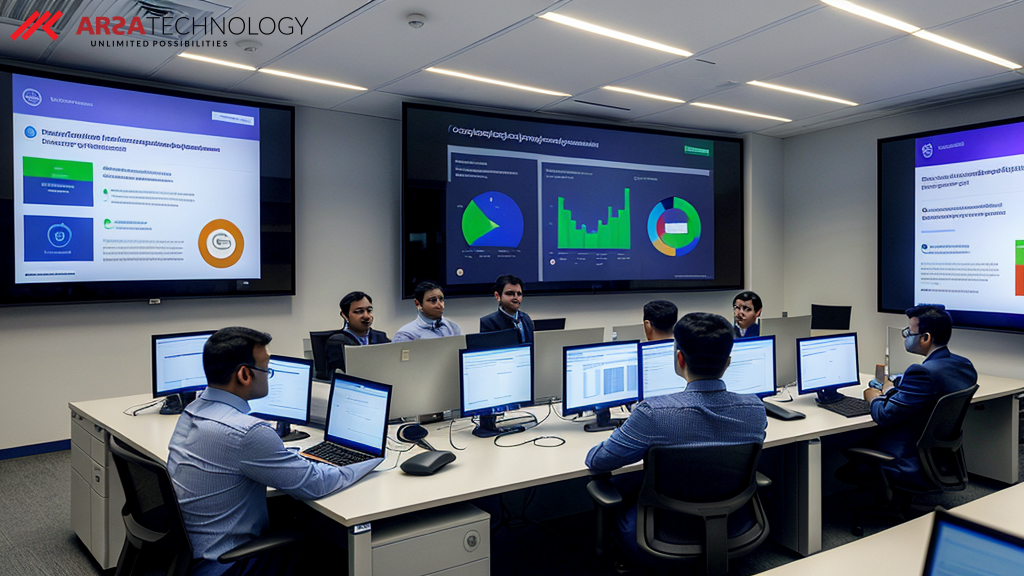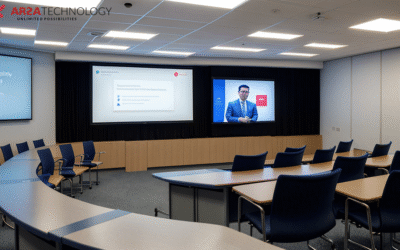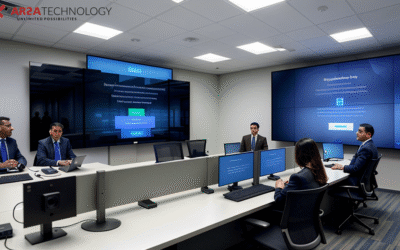Introduction: Overcoming Slow Digitization of Citizen Services in the Government Industry
Governments worldwide are under increasing pressure to modernize and digitize citizen services. The promise of seamless online interactions, faster processing times, and enhanced accessibility is compelling, yet the path to achieving this often encounters significant hurdles. A primary challenge is the secure and efficient verification of identity, a cornerstone for any digital public service. Traditional methods are often slow, resource-intensive, and prone to human error, contributing directly to the slow digitization of citizen services.
ARSA Technology’s Face Recognition API offers a powerful solution, enabling governments to implement robust and reliable identity verification processes. This biometric technology can transform how citizens interact with public services, from passport applications to social benefits, by making identity checks instant and secure. However, even with advanced tools, developers and solutions architects integrating these systems can encounter common challenges that impact performance and user experience. This guide addresses these issues head-on, providing practical, business-focused solutions to ensure your Face Recognition API implementation is not just functional, but truly transformative for public service delivery.
Ensuring Data Quality for Uncompromised Accuracy
One of the most frequent challenges in any facial recognition system stems from the quality of the input data. In government applications, where accuracy is paramount for preventing fraud and ensuring equitable access to services, poor image quality can lead to inaccurate matches, frustrating citizens, and delaying critical processes. Factors such as insufficient lighting, low resolution, blurriness, extreme angles, or partial obstructions (like masks or harsh shadows) can significantly degrade the API’s ability to perform reliable comparisons.
The business impact of this is substantial: increased manual review, longer processing times for citizens, and a potential erosion of trust in digital services. To mitigate this, developers must prioritize clear guidelines for image capture. While ARSA Technology’s API is designed for robustness, providing optimal input images significantly enhances performance. This means advising users on proper lighting, ensuring the face is centered and clearly visible, and using devices capable of capturing high-resolution images. Implementing client-side checks to guide users during photo submission can drastically improve data quality before it even reaches the API. By focusing on quality at the source, governments can ensure the integrity of their secure identity verification solutions and accelerate the digitization process.
Optimizing API Integration for Seamless Performance
Integrating a sophisticated API like ARSA’s Face Recognition API requires careful planning to ensure it operates efficiently within existing government IT infrastructures. A common issue arises from sub-optimal integration strategies, leading to latency, timeouts, or unexpected behavior. This isn’t about writing correct code, but rather about understanding the API’s operational requirements and how it interacts with other systems. For instance, making too many requests in rapid succession without proper rate limiting, or failing to handle network fluctuations gracefully, can impact the responsiveness of citizen-facing applications.
From a business perspective, integration challenges translate directly into poor user experience – slow loading times for identity verification, repeated attempts, and ultimately, citizen abandonment of digital services. Solutions architects should design their systems with resilience in mind, implementing strategies to manage request volumes effectively and ensuring robust error handling. Understanding the API’s expected response times and designing the user interface to provide feedback during processing can manage citizen expectations. To see the API in action and understand its capabilities, try our interactive demo on RapidAPI, which can help in planning your integration strategy. By optimizing integration, governments can ensure their digital services are not only secure but also consistently fast and reliable.
Addressing Scalability and High-Volume Demands
Government services often experience peak demands, whether it’s during tax season, election periods, or disaster relief efforts. A common challenge for digital identity verification systems is scaling to meet these fluctuating, often massive, volumes of citizen requests without degradation in performance. An API that performs well under normal load might struggle when thousands or millions of citizens attempt to verify their identity simultaneously, leading to service outages or significant delays.
The business implication of scalability issues is severe: inability to serve citizens during critical periods, public dissatisfaction, and a potential breakdown of essential services. ARSA Technology’s Face Recognition API is built on a robust, scalable infrastructure designed to handle enterprise-level loads. However, effective utilization requires foresight in system design. Developers should consider architectural patterns that distribute load, cache results where appropriate (for non-sensitive, temporary data), and monitor API usage to anticipate and respond to surges. Working with ARSA Technology’s support team can help in planning for high-volume scenarios, ensuring the infrastructure supporting your digital government initiatives can always meet demand.
Mitigating Security and Privacy Concerns with Advanced Biometrics
For government applications, security and privacy are not just features; they are fundamental requirements. A significant concern when implementing facial recognition is ensuring the integrity of the verification process and protecting sensitive citizen data. Common issues include the risk of spoofing attacks (e.g., using photos or videos to impersonate someone) and ensuring compliance with stringent data protection regulations. Failure to address these can lead to identity fraud, data breaches, and a severe loss of public trust, directly hindering the adoption of digital services.
To counter these threats, ARSA Technology emphasizes a multi-layered security approach. Beyond the core Face Recognition API, integrating additional biometric security measures is crucial. For instance, pairing facial recognition with preventing fraud with liveness detection is a powerful defense against spoofing. Our Face Liveness Detection API verifies that the person presenting their face is a live, present individual, not a static image or video. This significantly enhances the security posture of any identity verification process. To test the effectiveness of this critical security layer, you can test the Liveness Detection API. Adhering to strict data encryption standards and ensuring compliance with local and international privacy regulations (e.g., GDPR, CCPA) are also non-negotiable. By prioritizing these security measures, governments can build digital services that citizens can trust implicitly.
Managing False Positives and Negatives for Enhanced Trust
In identity verification, the concepts of false positives (incorrectly identifying someone) and false negatives (failing to identify someone correctly) are critical. For government services, a false positive could lead to unauthorized access to sensitive information or services, while a false negative could deny a legitimate citizen access, causing frustration and delays. A common challenge is balancing the API’s sensitivity to minimize both types of errors, especially in diverse populations or under varying conditions.
The business impact is profound: false positives undermine security and lead to fraud, while false negatives create barriers to service access, increasing administrative overhead and citizen complaints. ARSA Technology’s Face Recognition API provides confidence scores with its results, allowing developers to set appropriate thresholds based on the specific application’s risk tolerance. For high-security applications, a higher confidence threshold might be required, accepting a slightly higher rate of false negatives for increased security. For less critical services, a lower threshold might be acceptable to maximize inclusion. Continuous monitoring and fine-tuning of these thresholds, alongside ensuring high-quality input images, are key to optimizing the balance. This strategic approach ensures that the biometric system is both secure and inclusive, fostering greater trust in digital government initiatives.
Maintaining System Uptime and Reliability
For essential government services, system uptime and reliability are non-negotiable. Any downtime or inconsistent performance of the Face Recognition API can halt critical citizen interactions, leading to significant operational disruptions and public outcry. Common issues might include unexpected API service interruptions, network connectivity problems, or internal system failures that prevent the API from being called or its responses processed.
The business consequences of unreliability are severe: inability to deliver services, damage to government reputation, and potential economic costs associated with service recovery. To ensure maximum uptime, developers should implement robust monitoring systems that track the API’s availability and performance in real-time. Designing systems with redundancy and failover mechanisms can provide continuity in case of localized issues. Furthermore, staying informed about ARSA Technology’s service status and updates is crucial. Our commitment to high availability and continuous improvement means that our API is designed for enterprise-grade reliability, allowing government agencies to build digital services they can depend on.
Conclusion: Your Next Step Towards a Solution
The journey to fully digitized citizen services is complex, but the challenges associated with implementing secure and efficient identity verification are entirely surmountable with the right tools and strategies. Slow digitization of citizen services is not an inevitable fate; it’s a problem that can be solved by leveraging advanced biometric APIs like ARSA Technology’s Face Recognition API. By proactively addressing common issues related to data quality, integration, scalability, security, accuracy, and reliability, government agencies can unlock the full potential of facial recognition.
ARSA Technology is committed to empowering governments and developers with the high-performance AI API products needed to build a more secure, efficient, and citizen-centric digital future. Our Face Recognition API, complemented by our Face Liveness Detection API, provides a robust foundation for building trust and accelerating the delivery of essential public services. We encourage you to explore our capabilities and envision how ARSA Technology can support your mission to transform government operations.
Ready to Solve Your Challenges with AI?
Discover how ARSA Technology can help you overcome your toughest business challenges. Get in touch with our team for a personalized demo and a free API trial.






